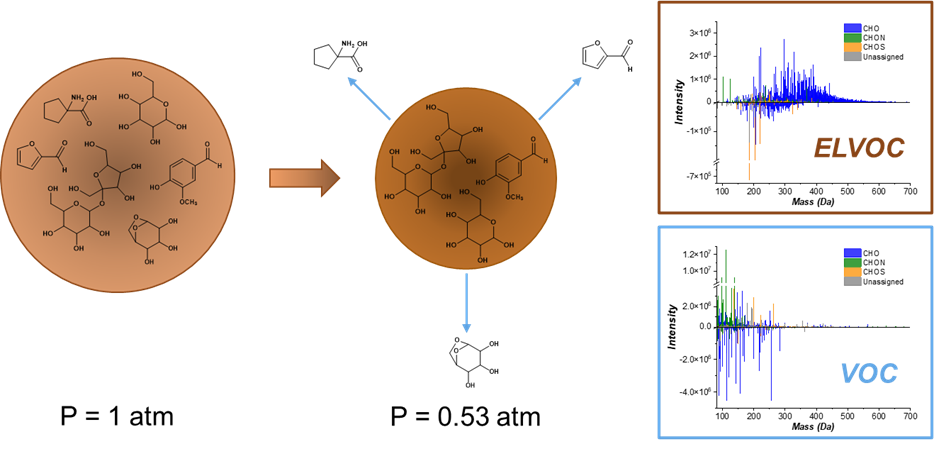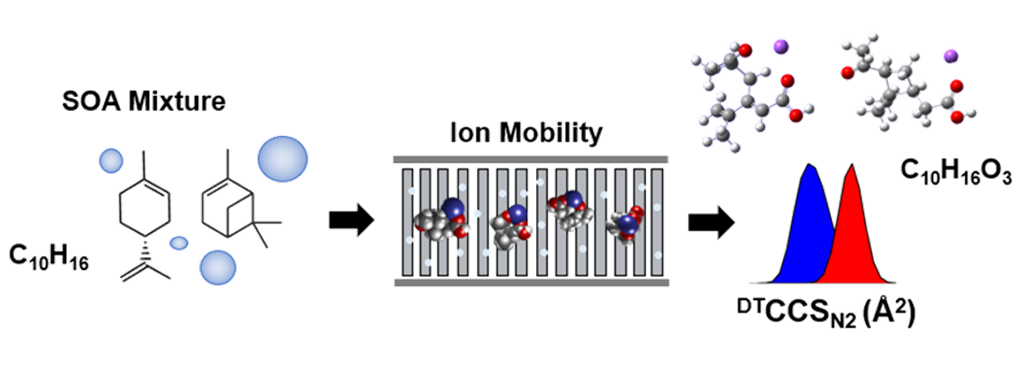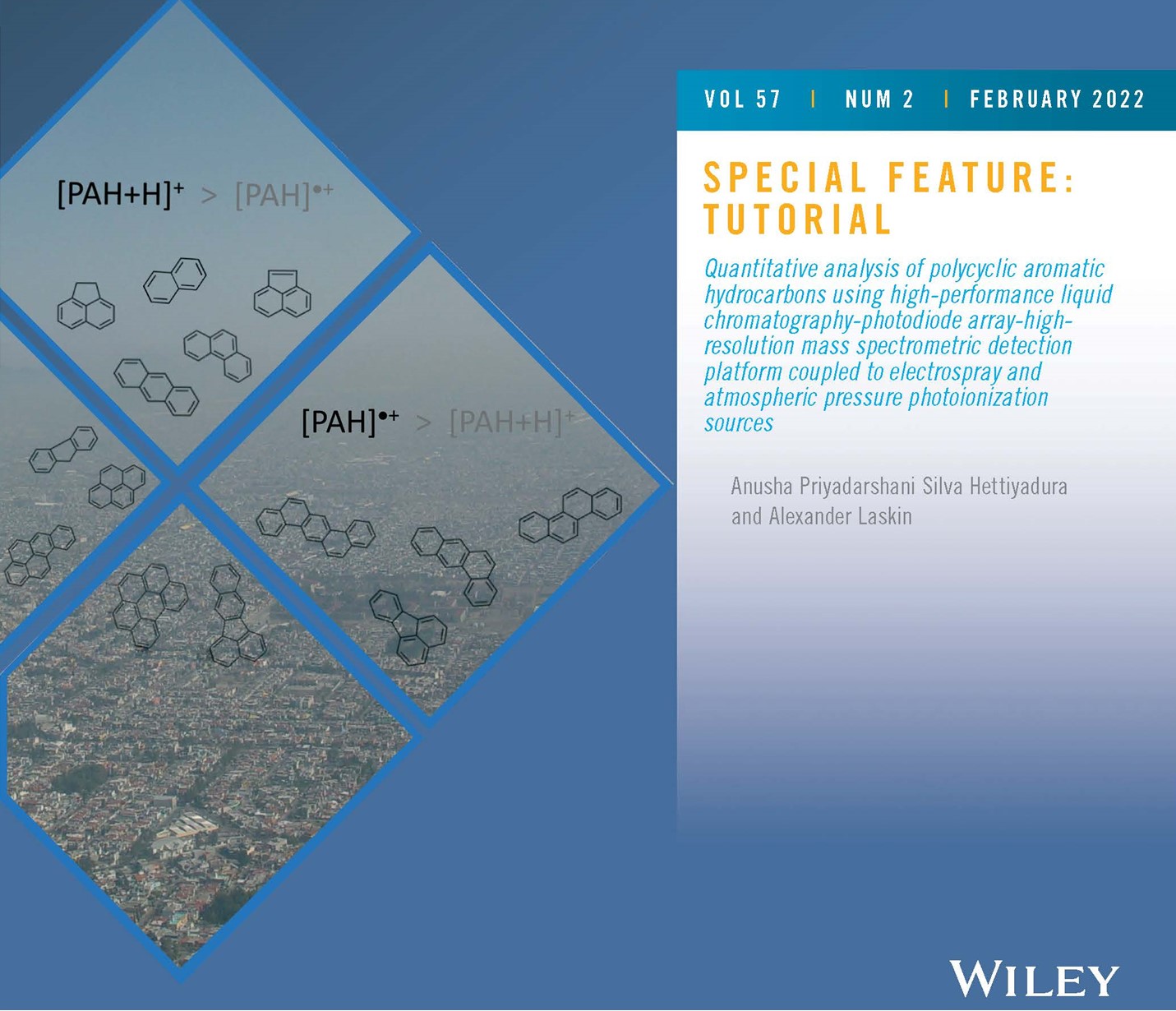Novel measurements
A range of analytical methods for microscopy, spectro-microscopy and molecular-level characterization of particle samples have been advanced in our research group, providing new experimental platforms to probe chemical composition and physical properties of aerosols. Recent Novel Measurements projects of our group are listed below.
Molecular Characterization of Biomass Pyrolysis Oil Surrogate Facilitated by Volatility-Based Separation
Advances in chemical characterization of raw bio-oils are necessary to inform the processing technologies and improve their commercial viability as either fuels or as stock chemicals. In our study, we investigate the molecular components of crude bio-oil materials, specific to their volatility-based separated fractions. We generate bio-oil aerosols followed by aerosol size-segregation complemented by sequentially reduced pressures as aerosol passes the impaction stages. We characterize molecular composition of the obtained bio-oil fractions using high-resolution mass spectrometry equipped with interchangeable electrospray ionization and dopant-assisted atmospheric pressure photoionization sources. We show that the volatility-based separation of raw bio-oils and application of complementary ionization techniques facilitate comprehensive characterization of their components with varying fuel viability, capable of guiding upgrading processes.
(Project supported by NSF grant No. IIP-1916691 and by industry partners)

Image Caption: Schematics of the volatility-based separation of the aerosolized components of crude bio-oil. Insert plots illustrate ESI (±) mass spectra of the Volatile (VOC) and the Extremely Low Volatility (ELVOC) fractions, respectively.
Relevant publication
E.R. Halpern, C.P. West, A.P.S. Hettiyadura, A. Darmody, J.K. Johnson, K. Qian, A. Laskin. Molecular Characterization of Biomass Pyrolysis Oil Surrogate Facilitated by Volatility-Based Separation. Energy & Fuels, (2023), In review.
Advanced Characterization of Isomeric Compounds in Atmospheric Organic Aerosol Using Ion Mobility-Mass Spectrometry
Secondary organic aerosol (SOA) formed through multiphase atmospheric reactions has very complex chemical composition that varies between different emission sources and aging processes, which complicates their identification. We employ drift tube ion mobility spectrometry with quadrupole time-of-flight mass spectrometry (IM-MS) detection for rapid gas-phase separation and multidimensional characterization of isomers in laboratory generated SOA mixtures. A novel application of IM multiplexing/ high-resolution demultiplexing methodology has been demonstrated for detailed molecular and structural detection and annotation of isomers in complex SOA mixtures.
(Project supported by NSF grant No. AGS-2039985)

Image Caption: Schematics of the ion mobility separation of isomeric components of SOA.
Relevant publication
C.P. West, D. Mesa Sanchez, A.C. Morales, Y.-J. Hsu, J Ryan, A. Darmody, L. Slipchenko, J. Laskin, A. Laskin. Molecular and Structural Characterization of Isomeric Compounds in Atmospheric Organic Aerosols Using Tandem Ion Mobility – Mass Spectrometry. Journal of Physical Chemistry A, (2023). Published online doi: 10.1021/acs.jpca.2c06459
Multi-Modal Quantitative Analysis of Polycyclic Aromatic Hydrocarbons
Polycyclic aromatic hydrocarbons (PAHs) are common pollutants present in atmospheric aerosols and other environmental mixtures. They are of particular air quality and human health concerns as many of them are carcinogenic toxins. They also affect absorption of solar radiation by aerosols, therefore contributing to the radiative forcing of climate. We performed comprehensive evaluation of the quantitative analysis of PAHs using the LC–MS platform and provided step-by-step guidance for an overall systematic approach that can be followed to determine the composition and light absorbing properties of individual PAH components in complex environmental mixtures.
(Project supported by NSF grant No. AGS-2039985)

Image Caption: Fragment of the Journal of Mass Spectrometry cover artwork featuring our special tutorial on the multi-modal quantitative analysis of PAHs.
Relevant publication
P. S. Hettiyadura, A. Laskin. Quantitative Analysis of Polycyclic Aromatic Hydrocarbons by Tandem Liquid Chromatography – Mass Spectrometry Coupled to Electrospray and Atmospheric Pressure Photoionization Sources. Journal of Mass Spectrometry, 57(2), e4804, (2022). doi:10.1002/jms.4804
